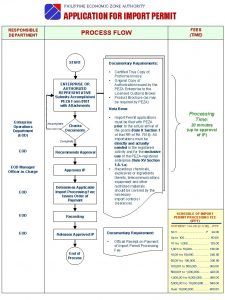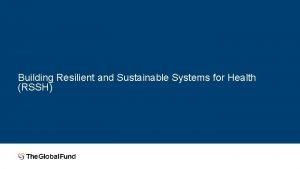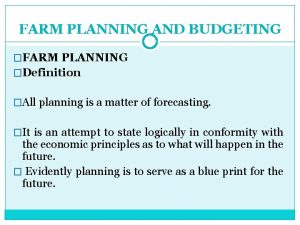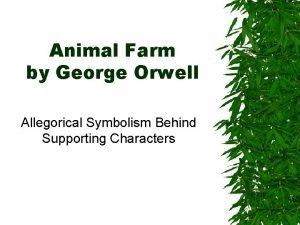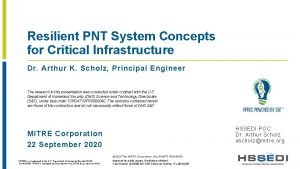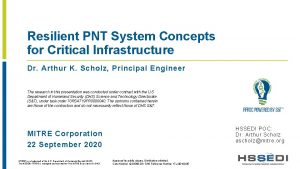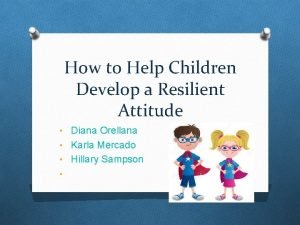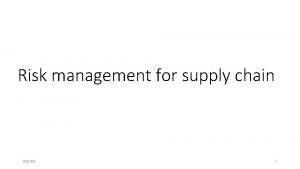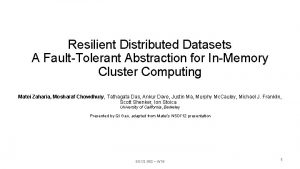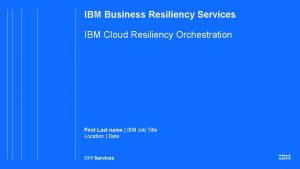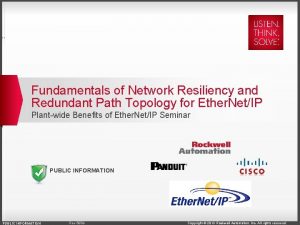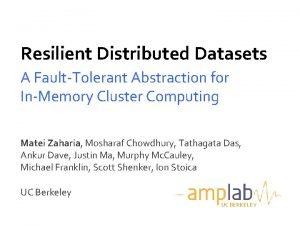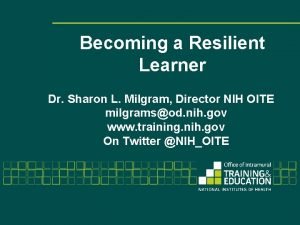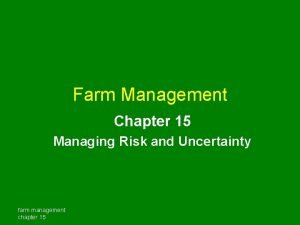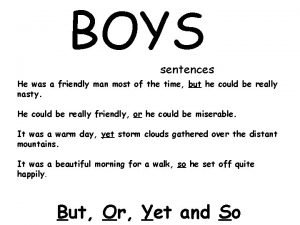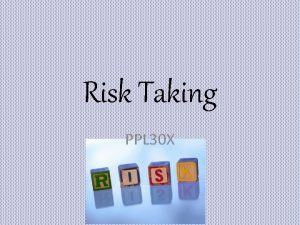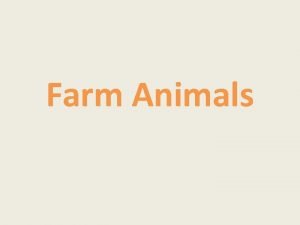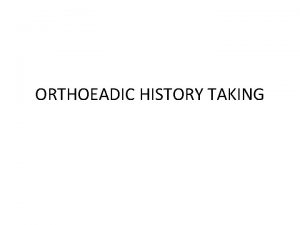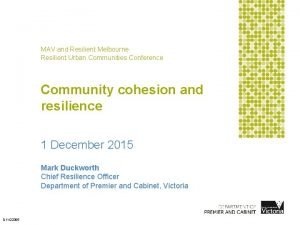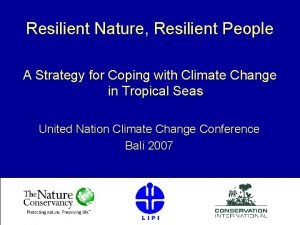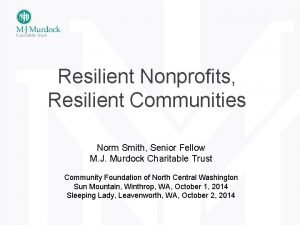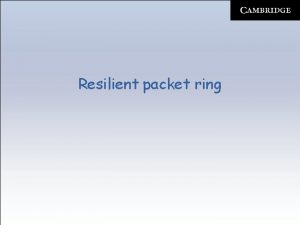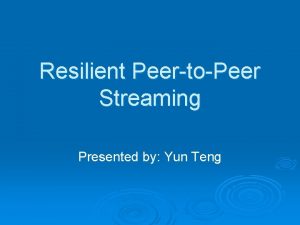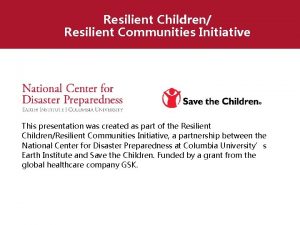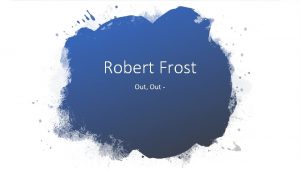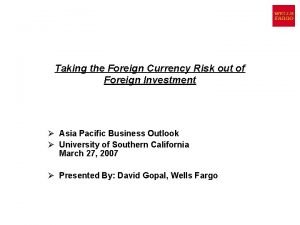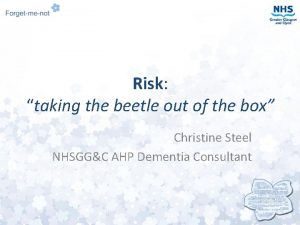Resilient farm systems taking the risk out of















































- Slides: 47

Resilient farm systems - taking the risk out of farming John Roche, Animal Science, Dairy. NZ Brendan Horan, Farm Systems, Teagasc Moorepark

“The only person that likes change is a wet baby”

“Markets love volatility” – Christine Lagarde WMP, US$/tob Oceania 6, 000 WMP 5, 000 4, 000 3, 000 2, 000 ? 1, 000 0 1999 2001 2003 2005 2007 2009 2011 2013



Format of the presentation • What is resilience? • Are our systems resilient? • Effects of recent changes to farm management in NZ • Characteristics of a resilient system

Resilience “the ability to absorb or manage change”

Resilience “the ability to absorb or manage change” 14 Shock 12 Resilience Value 10 8 6 4 Collapse 2 0 1 2 3 4 5 Time 6 7 8 9 10

Resilient businesses 1. are profitable every year 2. are environmentally benign 3. allow an adequate work-life balance for EVERYONE in the business 4. generate sufficient wealth in good years to provide opportunities in lean years

Resources Animals Pasture growth High N-use efficiency Supplementation High BW High MS & fert Easy Care Resilience Profit focussed Capital reserves Measure & budget Business Simple & Repeatable Sufficient time off Development opportunity People

Are we resilient?

Projected cash flow for ave Taranaki owner operator 40, 000 20, 000 0 -20, 000 -40, 000 -60, 000 -80, 000 ay M ril Ap ch ar M br ua ry y Fe nu ar r Ja be De c em be r r ve m be No to r Oc be em st Se pt Au gu ly Ju Ju ne -100, 000


What changes have we seen? 15, 000 14, 000 • Herd numbers declined 13, 000 14% 400 • Average herd size increased 60% 12, 000 600 5, 000 2012/13 2011/12 2010/11 2009/10 2008/09 2007/08 2006/07 2005/06 2004/05 2003/04 0 10, 000 • Milksolids production/ha increased 16% • Stocking rate increased: 9% • Milksolids production/cow increased 23% 2002/03 2001/02 0 350 300 250 200 150 11, 000 2000/01 2001/02 2002/03 2003/04 2004/05 2005/06 2006/07 2007/08 2008/09 2009/10 2010/11 2011/12 2012/13 10, 000 400 100 Herd size 800 2000/01 Milk yield, million L 20, 000 No of herds 25, 000 Milk fat/protein, million kg • National milksolids production increased 53% 1200 17, 000 No 37% of herds • National cow numbers increased Milk 16, 000 1000 Herd size fat • protein. Land allocated to dairying increased 26%

Industry intensification >60%ofoffarmers>20% 30% >10% purchased feed

$10, 000 $4. 50/kg MS $9, 000 $5. 50/kg MS $8, 000 $6. 50/kg MS $7, 000 $7. 50/kg MS $6, 000 $5, 000 $4, 000 $3, 000 $2, 000 Resilience Operating profit Plenty of research results and case studies to support $1, 000 $0 Low input Control Standoff Low Supp. Mod. Supp. High Supp.


“The problem with facts is that you can prove anything with facts!” -Homer J Simpson

Change in profit in NZ Real data – 285 -395 cows $ 1, 200, 000 $ 1, 000 Status quo – 285 cows $ 1, 200, 000 Revenue, $ Expenses, $ $ 1, 000 Free cash, $ $ 800, 000 $ 600, 000 $ 400, 000 $ 200, 000 $2002 2004 2006 Expenses, $ 2008 2010 2012 $2002 2004 2006 2008 2010 2012

Change in profit in NZ Average farmer is milking 100 cows more and making no more money! Revenue/Expenses/Free cash, $ $ 1, 000 $ 928, 054 $ 800, 000 Real - 385 cows $ 727, 520 Status quo - 285 cows $ 637, 403 $ 600, 000 $ 418, 225 $ 400, 000 $ 199, 723$ 219, 177 $ 200, 000 $Revenue Expenses Free Cash

Point 1 Increased milk production through intensification has not returned value to the average farmer.

Change in costs over the last decade 1. 80 1. 60 Feed Expenses, $/kg MS 1. 40 1. 20 Labou r Maintenanc e & Running Fertiliser Depreciatio Animal n health Overheads 1. 00 0. 80 0. 60 0. 40 0. 20 0. 00 20032004200520062007200820092010201120122013


What led to the increase in feed expenses 140, 000 700 100, 000 600 80, 000 500 60, 000 400 300 40, 000 20, 000 0 2002 2004 2006 2008 2010 2012 120, 000 $ 8. 00 100, 000 $ 7. 00 80, 000 $ 6. 00 60, 000 $ 5. 00 40, 000 Total feed bill $ 4. 00 20, 000 Milk price, $/kg MS $ 3. 00 200 100 0 0 2002 2004 2006 2008 2010 2012 $ 2. 00 Milk price, $/kg MS No of Cows Total feed bill/year, € 120, 000 $ 9. 00 800 No. of cows Total feed bill 140, 000

9 1500 R 2 = 0. 995 8 7 6 Operating profit/ha, € Pasture utilised/ha 10 Pasture utilisation and profit declined with supplement use in Ireland 1400 R 2 = 0. 9958 1300 1200 1100 1000 5 0. 0 2. 0 4. 0 Concentrate equivalent/ha, t Source: Ramsbottom et al. 2014 Journal of Dairy Science. 2015 0. 0 1. 0 2. 0 3. 0 4. 0 Concentrate equivalent/ha, t

Pasture utilisation and profit declines with supplement use in mid-Canterbury Pasture utilisation declines by 1. 2 t DM for every 1 t supplement purchased 16 14 12 R 2 = 0. 3641 1000 2000 6000 5000 4000 3000 2000 R 2 = 0. 5306 1000 10 0 7000 Operating profit, $/ha Pasture and Crop eaten, $/ha 18 3000 Purchased feed, kg/ha 4000 Operating profit declined 0 0 1000 for 2000 $910/ha every 3000 1 t Purchased feed, kg/ha supplement purchased 4000

The changes made over the last 6 years has eroded our low cost base Source: Hayley Moynihan, Rabobank


Herd size to earn the average national wage in the UK @ £ 0. 28/L No of cows to achieve national wage 450 413 400 350 300 250 200 150 139 100 53 50 50 0 Average Spring Top 25% Spring Average - All year Top 25% - All year

Point 2 The increase in feed costs has eroded our competitive advantage and undermined our resilience.

Resilient Systems

2, 000 Gord Ave top 20% Milksolids, kg/ha 1, 625 1, 490 1, 500 1, 300 1, 125 1, 100 1, 000 1, 075 1, 050 1, 025 500 2010 -11 2011 -12 2012 -13

$ 6, 000 Gord Ave top 20% $ 5, 150 Operating profit, $/ha $ 5, 000 $ 4, 400 $ 4, 600 $ 4, 200 $ 4, 000 $ 3, 000 $ 4, 100 $3, 050 $2, 800 $2, 700 $ 2, 000 $ 1, 000 $2010 -11 2011 -12 2012 -13

What makes us resilient?

$ 6, 000 Gord Ave top 20% Operating profit, $/ha $ 5, 150 $ 5, 000 $ 4, 400 $ 4, 600 $ 4, 200 $ 4, 000 $ $/kg 3, 000 MS Gord Feed costs 0. 42 $ Grazing 2, 000 0. 41 $2, 800 $3, 050 $ 4, 000 $ 4, 100 Average 1. 31 0. 35 $2, 70020% Top 1. 15 0. 42 2011 -12 2012 -13 $ 1, 000 $2010 -11

Dude I’m joking. You can feed supplements!

Resilient systems have stocking rate right and limit exposure to purchased feed Supplement fed/ha, t DM 400 kg Cow 500 kg cow Pasture grown, t DM/ha 12 14 16 18 20 0. 00 2. 4 2. 8 3. 2 3. 6 4. 0 1. 9 2. 2 2. 6 2. 9 3. 2 0. 25 2. 9 3. 4 3. 8 4. 2 2. 0 2. 3 2. 7 3. 0 3. 3 0. 50 2. 7 3. 1 3. 5 4. 0 4. 4 2. 1 2. 4 2. 8 3. 1 3. 5 1. 00 3. 4 3. 9 4. 4 4. 9 2. 3 2. 6 3. 0 3. 4 3. 8 1. 50 3. 3 3. 8 4. 3 4. 9 5. 4 2. 5 2. 9 3. 3 3. 7 4. 1 2. 00 3. 7 4. 2 4. 8 5. 4 5. 9 2. 7 3. 2 3. 6 4. 0 4. 4

Resilient systems – buy supplements at the right price Response to supplements, Breakeven price for g MS/kg DM supplements, % milk price 80 5. 0% 60 4. 0% 55 3. 5% 40 2. 5% 20 1. 5% tactical feed value is on a needs basis

To conclude

Resilient businesses • Have a strategic plan that doesn’t change with milk price • are profitable every year – not just when milk price is high • limit exposure to external forces • are Simple – Repeatable systems • are environmentally benign • can take advantage of others’ misfortunes

Projected cash flow for ave Taranaki owner operator 40, 000 20, 000 0 -20, 000 -40, 000 -60, 000 -80, 000 ay M ril Ap ch ar M br ua ry y Fe nu ar r Ja be De c em be r r ve m be No to r Oc be em st Se pt Au gu ly Ju Ju ne -100, 000

Tough times don’t last. Tough People do!


Intensification with a cost 120 8 Nitrate leached, kg/ha 7 Stocking rate 6 5 4 3 2 1 R 2 = 0. 9631 100 80 60 40 20 0 0 Feed Intensification 0 5 10 Stocking rate, cows/ha Increasing stocking rate through purchased feeds increases NO 3 leaching by 15 -20 kg/ha per extra cow

Invest in depreciating assets to reduce nitrate leaching 45 41 Nitrate leached/ha, kg 40 35 32 30 25 20 15 10 5 0 Control Standoff

Increasing stocking rate actually reduces NO 3 leaching 60 Nitrate leached, kg/ha 60 50 40 30 20 R 2 = 0. 7916 10 50 40 30 20 R 2 = 0. 8009 10 0 2 4 Stocking rate, cows/ha For every extra cow/ha in a ‘closed’ system, NO 3 leaching declines 12 kg/ha 6 200 225 250 275 300 Lactation length, days Reducing lactation length reduces NO 3 leaching by 9 kg/ha for each month less in milk

Point 3 Increased milk production through intensification has reduced nitrogen-use-efficiency and increased nutrient losses
 Peza 8105 meaning
Peza 8105 meaning The biggest risk is not taking any risks
The biggest risk is not taking any risks Resilient and sustainable systems for health
Resilient and sustainable systems for health Market risk credit risk operational risk
Market risk credit risk operational risk Personification in the song one thing by one direction
Personification in the song one thing by one direction Difference between partial budgeting and complete budgeting
Difference between partial budgeting and complete budgeting Harmouns
Harmouns Mollie animal farm represents
Mollie animal farm represents Positive risk-taking dementia
Positive risk-taking dementia Feature vectors
Feature vectors Resilient pnt
Resilient pnt Resilient pnt
Resilient pnt Resilient attitude
Resilient attitude Great oiled resilient striding legs analysis
Great oiled resilient striding legs analysis How can be more resilient
How can be more resilient How can more resilient
How can more resilient How can more resilient
How can more resilient Col shape gingiva
Col shape gingiva How can be more resilient
How can be more resilient Torpedo traffic generator
Torpedo traffic generator Network design concepts
Network design concepts Resilient packet ring
Resilient packet ring Resilient distributed datasets
Resilient distributed datasets Ibm cloud resiliency
Ibm cloud resiliency Redundant path
Redundant path Example of loopback address
Example of loopback address Resilient temperament meaning
Resilient temperament meaning Resilient distributed datasets
Resilient distributed datasets Resilient role models
Resilient role models Prepared and resilient learner
Prepared and resilient learner Risk and uncertainty in farm management
Risk and uncertainty in farm management Our luxury hotel turned out to be a farm building
Our luxury hotel turned out to be a farm building Farm lay out
Farm lay out Draw rmmm plan
Draw rmmm plan Risk mitigation avoidance
Risk mitigation avoidance How to calculate relative risk
How to calculate relative risk Residual risk and secondary risk pmp
Residual risk and secondary risk pmp Ar = ir x cr x dr
Ar = ir x cr x dr Absolute risk vs relative risk
Absolute risk vs relative risk Activity sheet 1 how diversified are these portfolios
Activity sheet 1 how diversified are these portfolios Firm risk scorecard examples
Firm risk scorecard examples Pembelanjaan risiko adalah
Pembelanjaan risiko adalah Key risk indicators for vendor management
Key risk indicators for vendor management Business risk vs audit risk
Business risk vs audit risk Business vs financial risk
Business vs financial risk Relative risk and attributable risk
Relative risk and attributable risk Risk map
Risk map Population attributable risk formula
Population attributable risk formula
